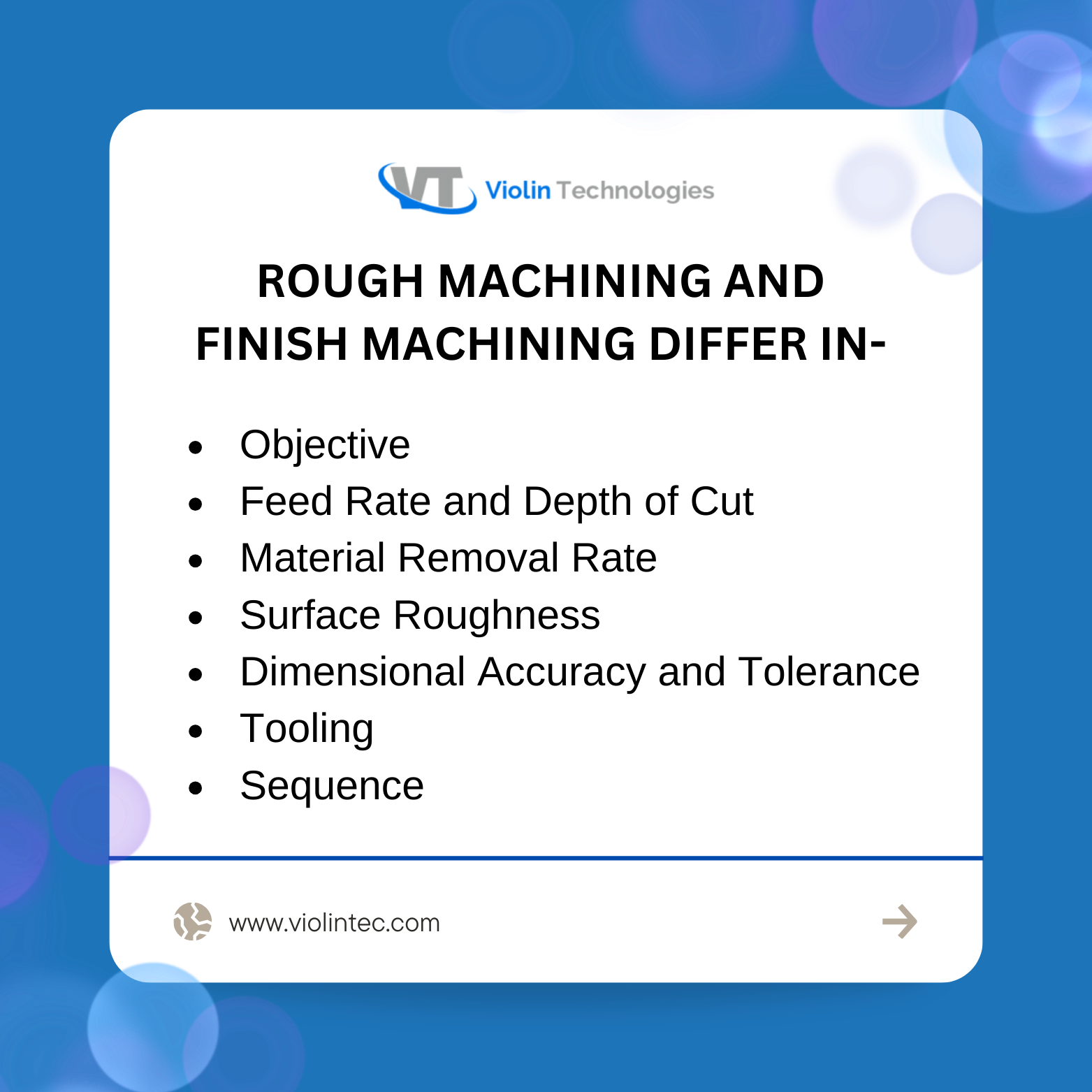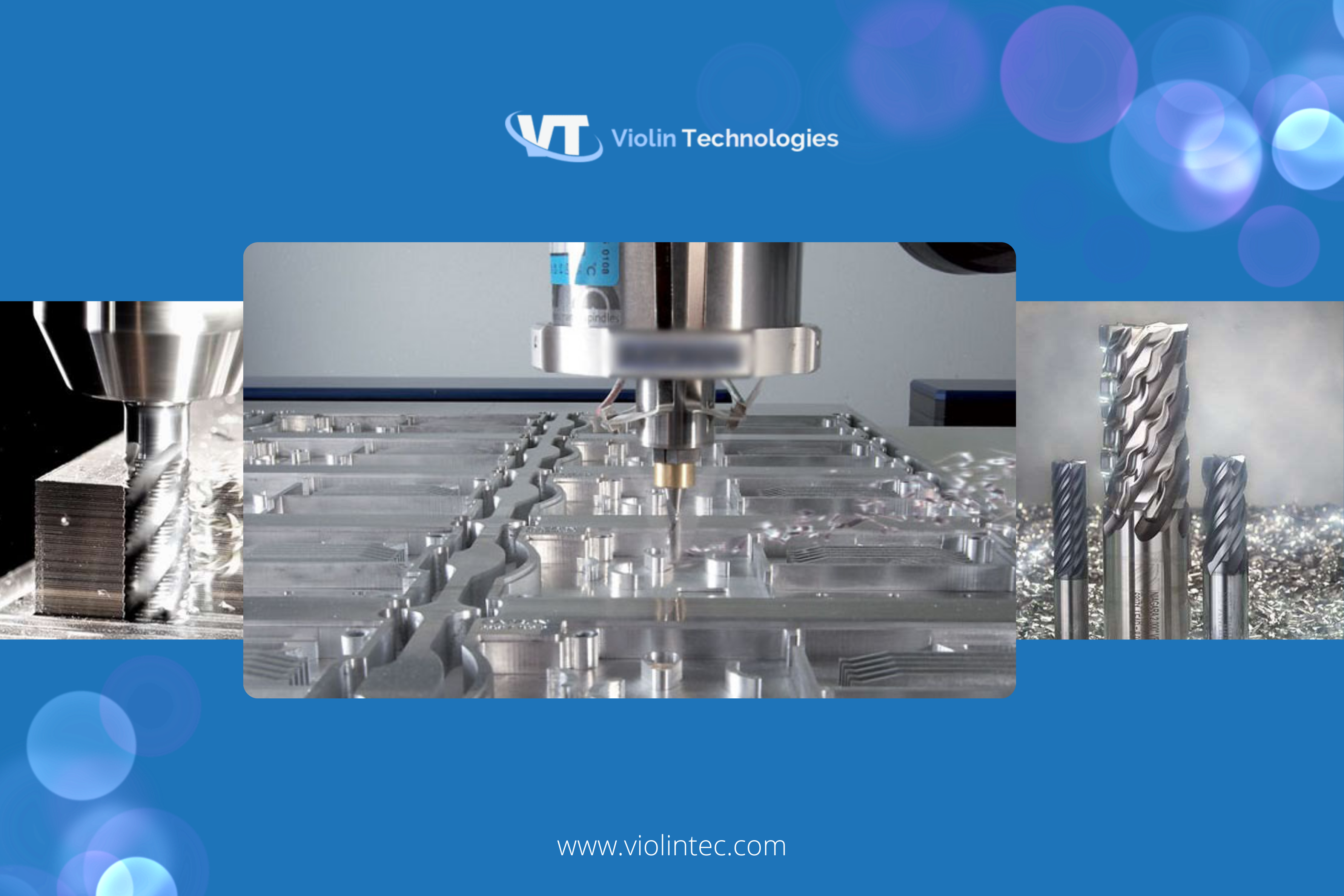Then comes the surface finish, the detail-oriented task that gives the part its smooth, polished look. Think of it as refining the rough edges left by the first step.
Together, roughing and finishing ensure that what starts as a solid block transforms into a precisely crafted component, each step contributing to the final dimensions and good surface quality in the CNC Machinery.
Rough Machining – Explained
In the manufacturing process, rough machining serves the vital role of swiftly eliminating substantial amounts of material to give the workpiece its desired shape. The primary surface roughness efficiently removes the excess material allowance from the blank, making subsequent processing smoother and more effective. Typically, during the roughing process, large feed rates and depth of cut(s) are employed to generate chips and expedite the process.
Consequently, products produced through roughing operations often exhibit lower precision and a coarse surface texture and boast high productivity due to the rapid material removal. However, it doesn’t deliver a polished surface finish or tight tolerances on its own. This preparatory cutting depth phase ensures that subsequent machining steps can operate with greater ease and precision.
Advantages Of Rough Machining
- Enhanced Feed Rates for Rapid Material Removal: Rough machining enables swift material elimination through high-speed feeds, with any errors corrected in subsequent semi finishing stages to ensure overall quality.
- Optimized Processing Equipment Utilization: By segregating processing stages, the advantages of both roughing and finishing equipment are maximized. Rough machining equipment, characterized by high power, efficiency, and rigidity, complements the precision and minimal error features of the final shape.
- Defect Identification and Timely Correction: Rough machining serves as a diagnostic stage, revealing defects like sand hole(s), air hole(s), or inadequate machining allowances in the blank. This early detection facilitates timely repairs or scrapping, preventing unnecessary processing time and cost.
- Residual Stress Management: Particularly beneficial after hot working, rough and finish machining can be separated to address the residual stress in the workpiece. These allow for strategic scheduling, where aging processes eliminate stress, and finishing stages correct any deformation post-cooling.
Finish Machining – Explained
Finishing in machining denotes a manufacturing phase focused on altering the surface of a produced part or component with specific objectives. These encompass the rectification of aesthetic imperfections to enhance the appearance of parts or attain particular mechanical properties for improved performance.
Typically, finishing operations comprise precision machining, grinding, electroplating, sandblasting, polishing, anodizing, powder coating, and painting. Manufacturers employ specific finishing techniques or a combination thereof based on the desired characteristics of the part, aiming to enhance properties such as hardness, adhesion, and corrosion resistance.
In the CNC manufacturing process, finish machining commonly follows rough machining, serving as the conclusive step. The primary goal of the finishing process is to eliminate excess material, ensuring the process parameters meet final specifications in terms of flatness, roughness, thickness, tolerance, and surface finish.
Additional considerations in finishing involve improving dimensional accuracy and sharp edges, ultimately delivering a refined and solid workpiece.
Crafting precision at its finest – we are the manufacturers of choice for precision machined components, ensuring excellence in every detail.

Key Differences Between Rough Machining and Finish Machining
1. Objective
Rough Machining: Aimed at removing a bulk amount of excess material swiftly.
Finish Machining: Focused on improving surface finish, dimensional accuracy, and tolerance.
2. Feed Rate and Depth of Cut
Rough Machining: Involves higher feed rates and deeper cuts for maximum material removal.
Finish Machining: Utilizes very low feed rates and shallow cuts to refine the surface.
3. Material Removal Rate (MRR)
Rough Machining: Achieves a high Material Removal Rate due to aggressive cutting parameters.
Finish Machining: Features a comparatively lower MRR as precision takes precedence.
4.Surface Roughness
Rough Machining: Results in higher surface roughness, contributing to a poor surface finish.
Finish Machining: Yields low surface roughness, delivering a good surface finish.
5. Dimensional Accuracy and Tolerance
Rough Machining: Does not prioritize high dimensional accuracy or tight tolerances.
Finish Machining: Aims for high dimensional accuracy and tight tolerances.
6. Tooling
Rough Machining: High ability to absorb cutting forces and allows the use of older or less sharp cutting tools.
Finish Machining: Requires a sharp cutter to achieve a refined finish.
7. Sequence
Rough Machining: Precedes finish machining in the overall machining process.
Precautions During Roughing Operations
1. Processing Parameters Optimization
While CNC roughing tools provide default options for feed rate, cutting speed, and depth, these may not suit every specific operation. Customizing and optimizing these cutting parameters for each workpiece and tool is essential to achieve final geometry.
2. Selection of Machine Tools and Software
Rough machining demands equipment with high power, efficiency, and rigidity. Manual cutting tools may lack the necessary capabilities for the cutting depth and result in poor surface finish.
Additionally, complex 3D milling software might struggle to maintain consistent cutting depth(s) on workpieces with narrow corners. It is crucial to select the right machining tools and software tailored for rough machining operations.
Contract manufacturers serve as your reliable partner for outsourcing excellence, demonstrating expertise in delivering top-notch quality and unwavering reliability.
Precautions For Finish Machining
1. Dimensional Accuracy Verification
Surface treatments applied during finishing may alter the GD&T and other dimensional features of manufactured components. For instance, coating metal parts with powder paint can increase the rough surface thickness.
Ensuring machining accuracy and precision before applying surface treatment is crucial. Regular checks are recommended to maintain dimensional accuracy.
2. Consideration of Applications
When choosing finishing operations, thoughtful consideration of the specific applications of parts and the potential environmental conditions they may face is essential. For example, finishing processes for hidden automobile parts may prioritize durability over aesthetics.
Tailoring finishing choices to the intended applications ensures the right balance between form and function.
3. Cost Evaluation
Beyond technical considerations, the overall cost of completing a project must be factored in. High-quality materials, powered cutting speed tools, and complex processes often accompany the best surface finish.
Evaluating the cost implications helps in making informed decisions and balancing the desired outcome with budget constraints.
By adhering to these precautions in both rough and finished machining, manufacturers can optimize efficiency, precision, and overall project success.
Key Takeaways
We have learned how selecting and implementing suitable machining processes at each stage of CNC machining is vital for project success. Therefore, understanding the operational principles of roughing and finishing remains crucial to attaining accurate components with exceptional surface quality.
Violin Technology offers professional CNC machining services to meet all your machining needs, covering everything from the initial roughing to the final finishing stages. It is dedicated to precision and excellence in every production partnership.
Feel free to request an immediate quote or contact us today for further assistance!

Almaas Saleem
About the Author
Almaas Saleem is a skilled software engineer from Kerala, India who currently resides in East Africa. She is passionate about technology and constantly seeks to learn more about it through reading and hands-on experience. Almaas excels in web development, design, automated testing software, ethical hacking, cybersecurity, and digital marketing. She also works as a technical writer for new businesses, managing various entities. Almaas is distinguished by her steadfastness and commitment to her work, which consistently ion.

